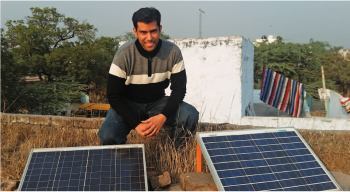
Image Caption
LIDS alum Kush R. Varshney visits Barauli, a small village in District Aligarh, India.Article Author
May 9, 2017
Link to Original Article
Signal Processing for Social Good
Communication, speech processing, seismology, and radar are well-known applications of signal processing that contribute to the betterment of humanity. But is there a more direct way that signal and information processing can reduce poverty, hunger, inequality, injustice, ill health, and other causes of human suffering? The member states of the United Nations ratified 17 sustainable development goals in 2015, which, if achieved by the targeted year 2030, will end or greatly curtail these problems. Achieving the global goals, however, will require cooperation from all, including the signal processing community. Let me tell you how.
In December 2016, I visited Barauli, a small village in District Aligarh, India where I had tea at the well-lit home of a Simpa Networks customer. A social enterprise, Simpa provides pay-as-you-go solar panel systems to households with inadequate access to power from the grid. The company installs a solar panel with lights and a fan—an alternative to unhealthy and unsafe kerosene lamps—for a very small down payment. Through a simple financing plan, customers can fully repay the cost of the system in monthly installments over two or three years. As a result, clean, reliable energy (and the well-being and economic opportunity that comes with it) is now within reach of people at the bottom of the pyramid—like the customer I visited, a driver and smallholder farmer.
Signal processing is the science behind Simpa’s sustainability. Two years ago, I led a team on a pro bono project to develop a predictive model of customer repayment behaviors based on signals captured in an application form. Specifically, we wanted to assess the risk of an applicant’s system being eventually repossessed due to payment delinquency, thus allowing Simpa to make better approval decisions. One operating point of the decision rule we developed could have reduced delayed payments by almost one-third while still accepting around 70% of the total customer pool.
This project is a prime example of the “data for social good” movement: uplifting humanity by harnessing skills-based volunteering of data scientists (of which I would argue signal processing engineers and scientists are a subset) in combination with the subject matter expertise of non-governmental organizations (NGOs), social enterprises, and other similar organizations. At IBM Research, I codirect (with Saška Mojsilovic ́) a program that pairs student fellows with a team of researchers and an NGO partner to conduct social good projects. Through this program—the first of its kind in a corporate setting—we have evaluated the effectiveness of programs fighting childhood diarrhea, found causal factors on the innovativeness of countries, and created a recommender system on the attributes of large philanthropic projects. Additionally, we’ve predicted species of primates likely to be reservoirs of the Zika virus, built tools to automatically retrieve and classify news articles on humanitarian crises, and developed cognitive technologies to accelerate open scientific discovery such as cures for multiple sclerosis—all using signal processing and related techniques.
The University of Chicago pioneered the concept of the Data Science for Social Good Summer Fellowship, which continues to spread in the academic setting with similar programs now offered at Georgia Tech and the University of Washington. Corporations and research organizations, like Two Sigma and Draper Laboratory, are following suit. Bloomberg hosts an annual conference on the topic. DataKind is a nonprofit that connects NGOs with volunteer teams to conduct projects in their spare time—this is how I worked on the Simpa project and another project using satellite image analysis of Kenyan households’ roofs to estimate poverty. DrivenData conducts online competitions to solve social good problems.
Fundamental signal processing theory and methods, when applied to non-traditional application areas, can change the world for the better. We have a unique opportunity to talk with NGOs, understand their most pressing needs, and use signal and information processing tools to create appropriate solutions. This is not a pipe dream but a reality.
Acknowledgment: This article originally appeared in the online blog of the IEEE Signal Processing Society on 7 February 2017.
Author: Kush R. Varshney (krvarshn[at]us.ibm[dot]com) received his B.S. degree (magna cum laude) in electrical and computer engineering with honors from Cornell University in 2004. He received his S.M. degree in 2006 and his Ph.D. degree in 2010, both in electrical engineering and computer science from the Massachusetts Institute of Technology. He is a research staff member and manager in the Data Science Department at the IBM Thomas J. Watson Research Center. He also codirects the IBM Social Good Fellowship Program.


